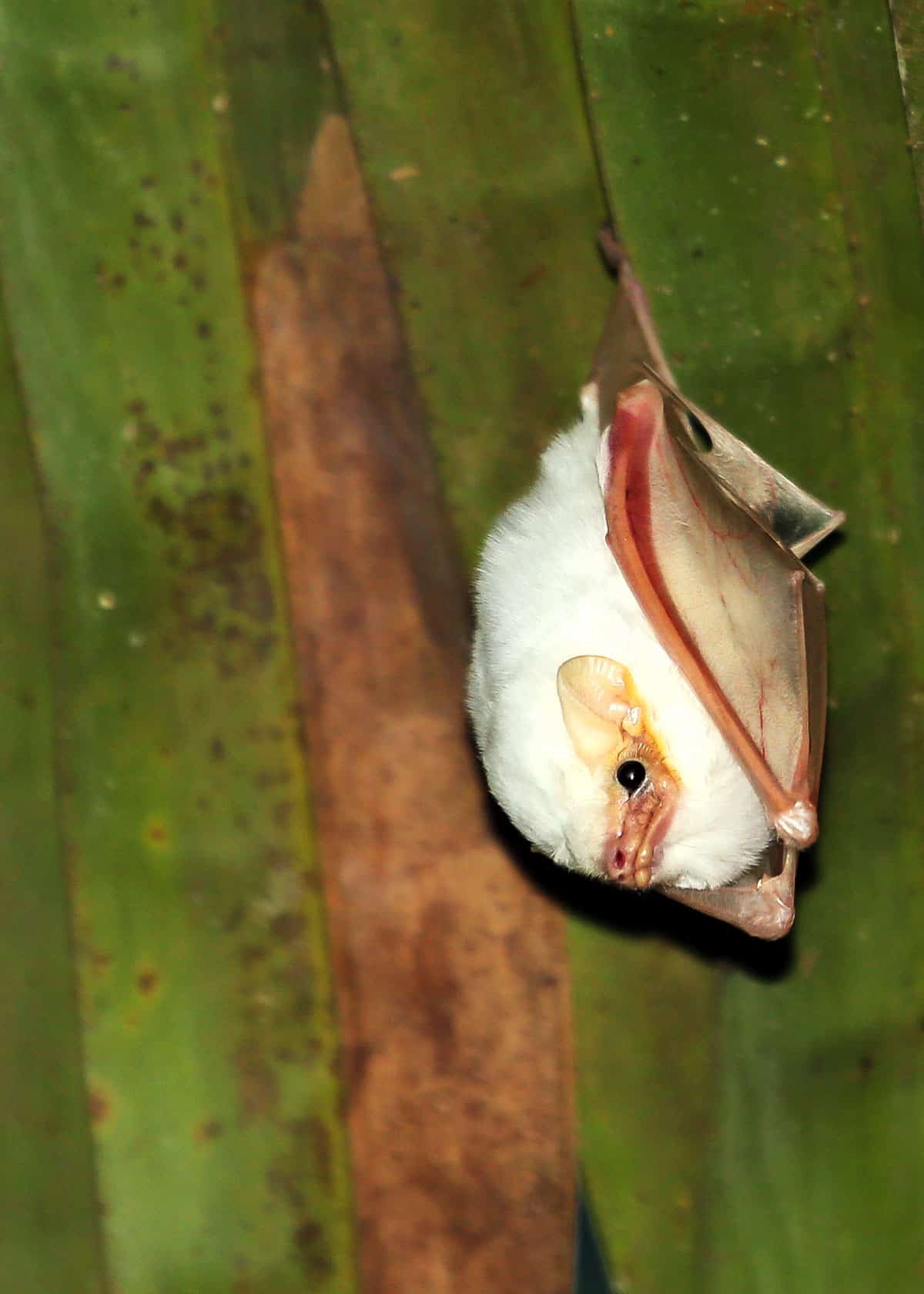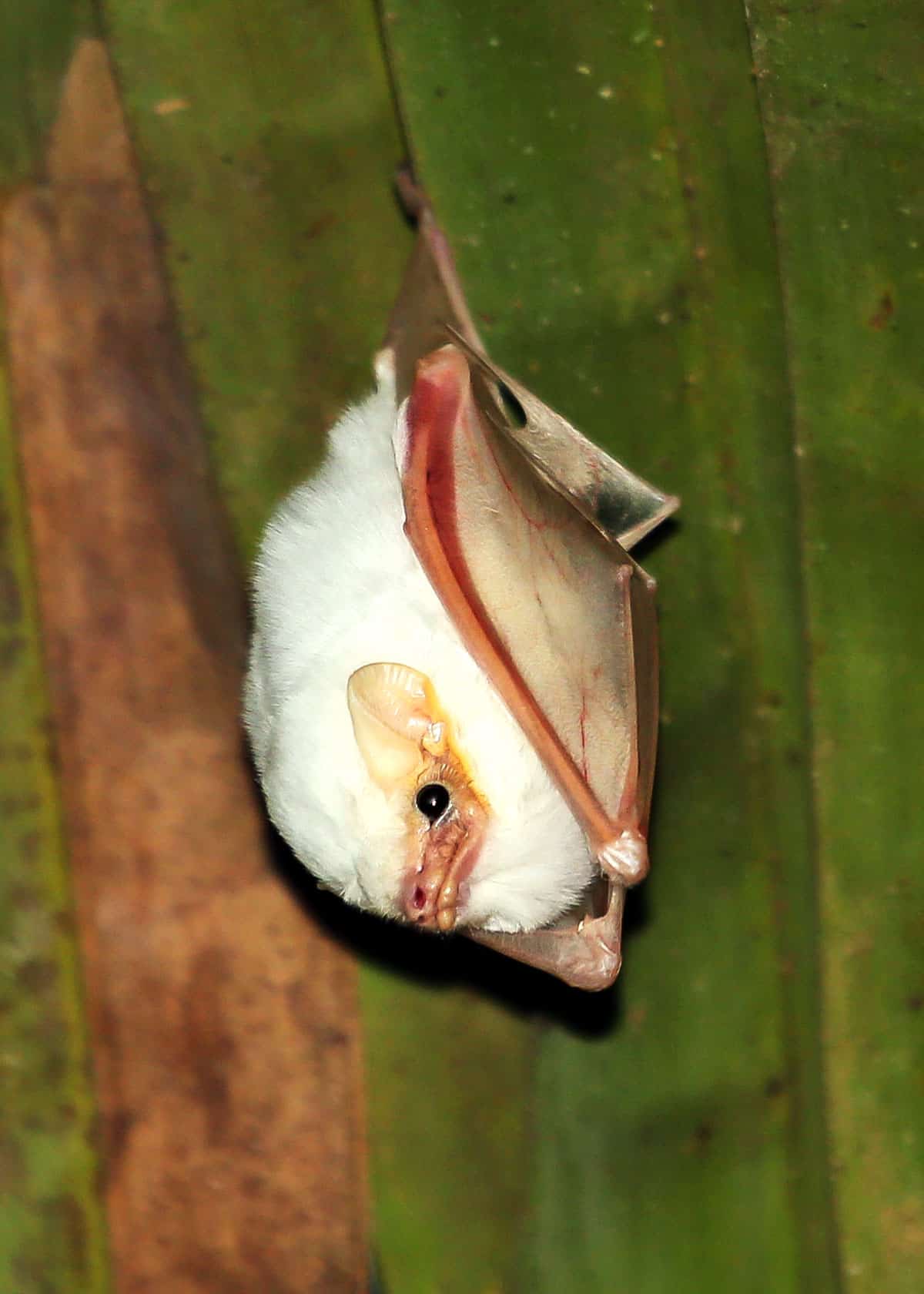Looking to learn about the adorable Honduran white bat? You’re in the right place! Here I’ll tell you all about them: diet, habitat, and fun facts.

Table of Contents
23 Facts about the Honduran White Bat
This largely unknown bat species is a unique feature of the bat family.
Let’s get to know this beautiful little creature that many describe as the “Furby” or “marshmallow puff” of the bat family.
1. What does the Honduran white bat look like?
Honduran white bats are adorable bats covered in white fur, as the name would suggest.
They feature a distinctive leaf-shaped nose that grows up and away from their face.
View this post on Instagram
Their ears, face, nose, and parts of their limbs are a wonderful, bright orange.
Scientists think they have a natural form of sunscreen as well in the form of a black membrane that covers their skull and repels ultraviolet radiation.
2. Why are Honduran white bats white?
Researchers aren’t exactly sure why the Honduran white bat displays its distinctive white color.
The most likely theory is that white reflects the color of green on their leaf roosts making them harder to spot.
Most bats are brown and black, and there are only two known species of bats out of about 1300 that boast that distinctive white color. This makes the Honduran White Bat quite a little gem.
3. How big is a Honduran white bat?
This is a small species of bat that measures around 4-5 centimeters. Their size makes it easier for them to roost in their distinctive tent leaves.
They have a small wingspan of about ten centimeters. They can fit into the palm of your hand and easily nest with five to six others in the broad leaves of fruit trees.
4. How much does a Honduran white bat weigh?
They weight just five to 6 grams, which is about the weight of 5 standard sugar packets. Isn’t that adorable??
5. Can Honduran white bats fly?
Yes. Honduran white bats can fly just as well as some of their much larger peers.
They roost in leaves very high off the ground to keep away from predators. This habit, along with food gathering, requires flight.
6. What is the Honduran white bats Latin name?
The Honduran bat’s official name is Ectophylla alba, a name given to them in 1892 when they were officially recognized as a separate species.
It’s the sole member of Ectophylla.
7. What other names does the Honduran white bat have?
It’s also known as the “Caribbean white tent-making bat” in homage to its distinctive sleep habits. It’s also known as one of the “cutest” bats to many in the field.
The bat isn’t well known outside most research circles, so it hasn’t developed as many common nicknames as other animals have; although that could change as people get to know this tiny treasure.
8. Are Honduran white bats friendly?
It might be a stretch to call them friends, but they are timid and sweet. Many prefer to hide from humans.
For the most part, they stay quiet and keep to themselves to survive in their habitats.
View this post on Instagram
9. Are Honduran white bats aggressive?
No, these bats prefer hidden places instead of striking out at people and predators.
Their small size makes them great hiders, and they’re unlikely to be aggressive if you run across a colony.
They respond well to human interaction for those who have been lucky enough to hold or handle one and are mostly docile.
10. Do Honduran white bats bite?
Possibly, but very unlikely. They don’t typically bite humans because their teeth are small and more suited to eating fruit.
In this photo, you can see what may appear to be menacing teeth. Likely though, this little guy is just yawning, not snarling. Isn’t he cute!?
View this post on Instagram
Check out another cute animal, the axolotl!
Although they may clamp down if they feel threatened, most are ok with being held – by an expert.
They definitely aren’t the type to suck blood or even attack insects, so the threat of a bite is extremely low.
11. How long do Honduran white bats live?
They’ve been known to live up to 20 years.
12. What eats a Honduran white bat?
Unfortunately, quite a few animals are able to prey on these little guys. Predators include most carnivores in their area – that are able to climb to the bat’s roosting spot.
These include snakes, owls, possums, and raptors.
13. Is the Honduran white bat endangered?
It’s classified as “near threatened” on the endangered species list, so while it’s not currently considered endangered, threats to habitats have put it on the watch list.
Researchers continue to monitor numbers in the wild to make sure that steps are taken to preserve this unusual species if problems occur.
14. What do Honduran white bats eat?
They’re fruit eaters like most tent-making bats. They may strike out and eat other things in a pinch, but their behavior places them in the leaves of a fruit tree near their favorite source of food.
They specialize in a particular species of fig that produces an asynchronous crop, meaning there’s usually a source of food from a tree all year round.
The bats move their roosts but tend to congregate around these fig trees regardless of location.
15. How does the Honduran white bat find food?
The Honduran white bat’s usual method is to set up a roost in the leaves of a fruit tree. This way, they don’t have to set out very far to find food.
They move from tree to tree to prevent being detected by predators and to follow the fruiting cycle of trees.
16. Do Honduran white bats mate for life?
There’s very little real information about their mating and reproduction habits, but we do know that colonies are frequently made up of a single male and as many as six females.
View this post on Instagram
Whether they mate for life with a single male is up for debate and honestly not well understood.
17. Are Honduran white bats loud?
They aren’t very loud and tend to communicate through visual means and through touch.
18. Do Honduran white bats carry disease?
There’s a small danger of rabies, but most bats have less risk than ground-dwelling animals.
For these species, it’s far more likely that the bat will succumb to predators or habitat changes than a disease.
Because the threat of a bite is rare, the stereotypical fear of disease-carrying bats doesn’t really apply to this species (although to be entirely fair, it doesn’t apply to most species of bat).
19. Where does the Honduran white bat live?
This species is found in Central and South America and is unusual as one of the only species of leaf-nosed bat found in Central America.
They populate around areas where their favorite fig trees are present and usually around an elevation of 0-700 meters above sea level.
They prefer the wet, green vegetation of forests and secondary forests because its food supply is always readily available along with reliable places to roost in leaves.
20. What is the habitat of the Honduran white bat?
Their habitats are lowland rainforests. The bat relies on the dense presence of large leaves to make roosts at night, so without those leaves, the bats are highly vulnerable.
Their habitats are warm and produce fruit year round for a constant food supply.
The bats are highly vulnerable to deforestation because their habitat requires very specific conditions to protect and feed them. One of the biggest threats to this species is human encroachment into their habitats.
21. Do Honduran white bats hibernate?
No. They have no need to hibernate because their climate remains pretty constant throughout the year.
Most animals that don’t live in a cold climate don’t fall into a species that hibernates.
22. Where can I see the Honduran white bat?
Not many zoos display the Honduran white bat because they’re nocturnal and hide under the leaves during the day. It’s difficult to find a way to display bats in general, and this is particularly true of this species.
Your best bet is to find an ecology class tour that can help gently tease out the colonies in the wild.
If you really want to see one, ecology tours such as those offered in Costa Rica that can respect the habitat and this tiny creature’s way of life are some of the best bets.
Puff Balls
We hope you’ve enjoyed learning about these weird little cuties! Still have questions? Let me know in the comments and I’ll do my best to answer them!
Drew Haines is an animal enthusiast and travel writer. She loves to share her passion through her writing.
She graduated high school at sixteen and started her own business, Everywhere Wild Media. And she runs Everywhere Wild and JustBirding. She also guest blogs on Storyteller.Travel
She lived in Ecuador for 6 years and explored the Galapagos Islands. Currently based in N.S., Canada.



Gloria
Sunday 8th of August 2021
We live in Southern New Mexico and my daughters house is nearby. They have seen bats flying about near her house and one of them looks solid white. Is this unusual?